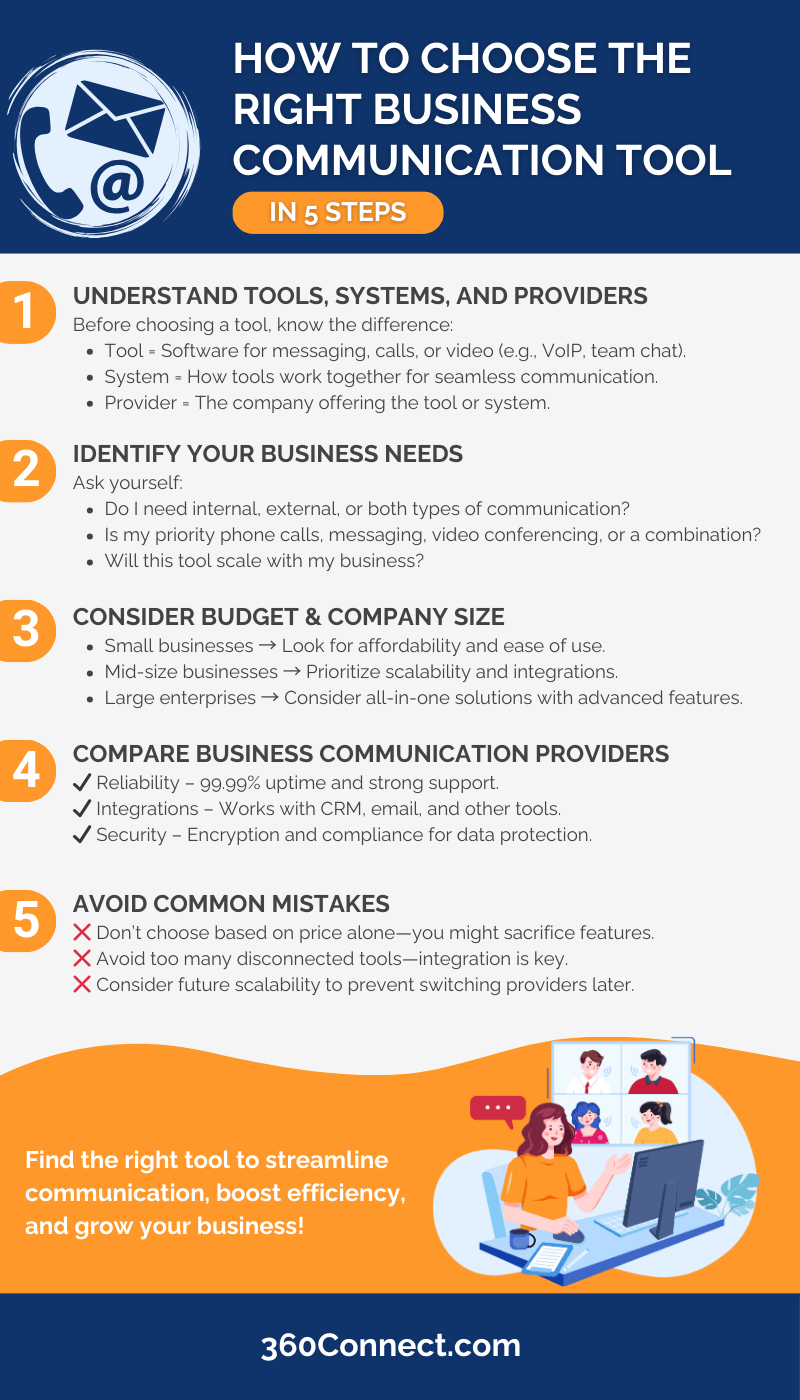Communication is at the core of every successful business. Whether you’re answering customer inquiries, collaborating with employees, or managing remote teams, the way you communicate directly impacts productivity, customer satisfaction, and efficiency. But with so many different Business Communication Tools available, how do you decide which one is the best fit for your company?
The reality is, not all tools are created equal, and choosing the wrong one can lead to wasted time, frustrated employees, and even lost revenue. A system that works for one business might be completely wrong for another, which is why it’s critical to take a step back and evaluate what you actually need. Are you primarily handling customer interactions, internal collaboration, or a mix of both? Do you need something that will scale with your business as you grow?
To make this process easier, we’ve broken it down into five key steps to help you identify the right Business Communication Tool based on your needs, budget, and business size.
In 2023, 75% of people adopted a new tool to improve their business communication.
5 Steps to Choose the Right Business Communication Tool
Choosing the right Business Communication Tool isn’t as simple as picking popular software. The best tool for your business depends on how you communicate, whether it’s through phone calls, messaging, video meetings, or a combination of all three.
A well-chosen Business Communication Tool can:
- Improve team collaboration and efficiency
- Help you deliver better customer service
- Prevent missed messages, disorganized workflows, and communication bottlenecks
To make sure you’re choosing the right tool for your needs, follow this five-step process:
- Understand the difference between a Business Communication Tool, System, and Provider.
- Determine what communication challenges your business needs to solve.
- Factor in budget and company size to find a scalable, cost-effective tool.
- Compare different Business Communication Providers and their features.
- Avoid common mistakes that could lead to inefficiencies or unnecessary costs.
By following these steps, you’ll be able to choose a Business Communication Tool that fits your workflow, integrates smoothly with your processes, and scales as your business grows. Let’s dive in!

STEP 1: Understanding Business Communication Tools, Systems, and Providers
Before diving into specific tools, it’s important to understand how business communication is structured. Many business owners mistakenly assume that picking a tool is as simple as signing up for the latest software, but in reality, there are three major components that make up a complete communication system:
- Business Communication Tool – The software or platform that enables calling, messaging, or video conferencing.
- Business Communication System – How multiple tools work together to create an organized communication flow.
- Business Communication Provider – The company that sells and supports the tool or system.
These three work together to ensure that your communication is efficient, reliable, and scalable
What is a Business Communication Tool?
A Business Communication Tool is any software or platform that allows businesses to send messages, make calls, or host video meetings internally or externally. Think of these as individual solutions that handle specific types of communication.
Some tools are designed for internal use, like messaging apps that help teams collaborate. Others focus on external communication, such as VoIP phone systems that allow businesses to manage customer calls professionally. Some platforms combine multiple communication features into one.
Examples of Business Communication Tools:
- VoIP Phone Systems – Replaces traditional phone lines with internet-based calling (e.g., RingCentral, Vonage).
- Video Conferencing Software – Used for virtual meetings and webinars (e.g., Zoom, Microsoft Teams).
- Team Messaging Apps – Helps teams communicate quickly (e.g., Slack, Discord for Business).
- Customer Communication Platforms – Handles multi-channel customer support (e.g., Zendesk, HubSpot).
What is a Business Communication System?
A Business Communication System is the bigger picture—it’s how multiple tools are integrated to work together. Instead of using disconnected software, a system ensures that all tools communicate seamlessly across different teams and departments.
For example, a company may use:
- Slack for internal chat to keep employees connected.
- Zoom for virtual client meetings and presentations.
- RingCentral for handling customer calls and managing voicemail.
If these tools aren’t connected, employees might waste time switching between platforms, re-entering customer data, or experiencing miscommunications. But when set up as a system, all tools sync together, so data and conversations flow smoothly between departments.
Related: Types of Business Communication Systems
What is a Business Communication Provider?
A Business Communication Provider is the company that sells and supports the tools businesses use. Some providers specialize in one type of communication (like video conferencing), while others offer all-in-one systems that include VoIP, messaging, and collaboration tools.
Types of Business Communication Providers:
- Single-Function Providers – Focus on one tool (e.g., Zoom for video conferencing).
- All-in-One Providers – Offer complete systems (e.g., RingCentral for VoIP, messaging, and video).
- Industry-Specific Providers – Specialize in tailored communication solutions (e.g., Zendesk for customer support).
STEP 2: Identify What Business Communication Tool Your Business Needs
Now that you understand the structure of business communication, it’s time to figure out what tool your business actually needs. This step is crucial because not every tool is a good fit for every business.
For example, a small retail business with minimal internal communication might only need a VoIP phone system to manage customer calls. A tech company with multiple remote employees, on the other hand, might require a full system that includes team messaging, video conferencing, and phone integration.
Key Questions to Ask:
- Do I primarily need internal communication, external communication, or both?
- Are customer calls the biggest priority, or do I need a mix of messaging, video, and phone?
- Will my business grow in the next 3-5 years? (Scalability matters!)
- Do I need communication tools that integrate with my CRM or project management software?
STEP 3: Consider Your Budget and Business Size
Choosing the right Business Communication Tool is not just about features—it’s also about affordability and scalability. Businesses that don’t consider long-term costs often find themselves overpaying or needing to switch providers too soon.
How Business Communication Tools Are Priced:
- Per-User Pricing – Monthly cost based on the number of employees using the tool.
- Flat-Rate Pricing – A set monthly fee, regardless of how many employees use it.
- Feature-Based Pricing – Costs vary depending on features like call recording or video conferencing.
Hidden Costs to Watch Out For:
- Setup Fees – Some providers charge an installation fee.
- Overage Charges – Exceeding usage limits can result in extra costs.
- Add-On Features – Some providers charge extra for integrations and advanced features.
STEP 4: Compare Business Communication Providers
Once you’ve determined your budget and business needs, the next step is choosing a provider that aligns with those needs. Not all providers offer the same level of support, integrations, or scalability.
What to Look for in a Provider:
- Reliability – Does the provider offer 99.99% uptime for consistent service?
- Customer Support – Is 24/7 support available via chat, phone, or email?
- Integrations – Can the tool sync with your existing software (CRM, email, etc.)?
- Security & Compliance – If handling sensitive data, does the provider offer strong encryption and compliance certifications?
STEP 5: Mistakes to Avoid When Choosing a Business Communication Tool
Selecting a Business Communication Tool is a major investment in your company’s productivity, efficiency, and customer service. However, many businesses rush into a decision without fully considering long-term needs, leading to frustration, inefficiencies, and unnecessary costs.
To avoid costly mistakes, be aware of these common pitfalls when choosing a Business Communication Tool:
- Not considering future growth – A system that works today might not be scalable for tomorrow.
- Choosing based on price alone – The cheapest tool might lack essential features.
- Ignoring integrations – A tool that doesn’t connect with existing systems can slow down workflows.
- Overcomplicating your setup – Too many disconnected tools can create inefficiencies instead of solving them.
How the Right Business Communication Tool Leads to Success
When you choose the right Business Communication Tool, you’re not just improving how your team communicates—you’re optimizing workflows, enhancing customer satisfaction, and future-proofing your company’s communication strategy.
A well-structured communication system leads to:
- Faster response times – No more delays or missed calls from customers and clients.
- Improved internal collaboration – Teams can work efficiently with the right messaging and video conferencing tools.
- Higher productivity – Employees waste less time switching between disconnected platforms.
- A professional business image – Reliable phone systems and communication channels build credibility.
- Scalability – As your business grows, your communication system can grow with you.
By following a step-by-step approach to selecting a Business Communication Tool, you ensure that your business operates efficiently, keeps employees connected, and provides exceptional customer service.
Final Thoughts
Every business has different communication needs, which means there’s no one-size-fits-all solution. The right Business Communication Tool depends on factors like your company size, industry, budget, and specific communication challenges.
Taking the time to assess your current setup, define your must-have features, and compare providers will help you avoid common pitfalls like overpaying for unnecessary features or choosing a tool that doesn’t scale with your business.
At the end of the day, a well-integrated communication system isn’t just about technology—it’s about efficiency, productivity, and customer satisfaction. Investing in the right tool now will set your business up for long-term success.
Get Free Business Communication Quotes
Looking for the best Business Communication Tool for your company? Whether you need a simple VoIP phone system or a full-featured communication platform, we can help you find the right provider for your company.
- Compare top providers
- Get competitive pricing
- Receive no-obligation quotes

